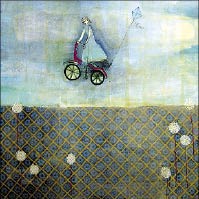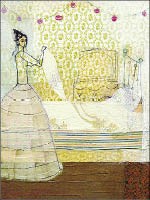Standing in the middle of “Rana Rochat: Paintings,” the current exhibition at the David Lusk Gallery, what one notices first are lines looping across saturate fields of ochre and coral, circles floating in earth-toned atmospheres, and everywhere the soft glow of beeswax.
The show’s strongest paintings combine luminous sweeps of color and line with complex environments that work on several levels. Untitled L511 could be an homage to time. In the painting’s middle panel, translucent whites through multiple layers of black evoke eons and the vastness of space. In the left panel, marks on a white wall create irregular rectangles and suggest traces of history inscribed on stone slabs. And in the right panel, lines crisscrossing and flowing over the edges of warm, glowing coral feel like life in the here-and-now.
Untitled L509 broaches the ineffable. Delicate white lines explore a pitch-black middle surface, and scumbled grays cross the panel to the right like jumbled images on a monitor. Three balls of gray beeswax hover to the left. The balls, which are stacked totemlike, dominate the picture plane and are translucent. But rather than reflecting the world with crystal clarity, these spheres are complex, searching the shadows for what Rochat describes in her artist’s statement as “intuition, gut feelings, and the profound experience of mystery that a painting has the potential to provide.”

Both Rochat’s muted, enigmatic paintings and her more luminous, free-flowing works elicit visceral reactions and personal associations. For example, in Untitled L480, black ellipses swerve across and light grays dribble down the right panel. This, combined with the faint white light that glows through layers of dark-gray encaustic, creates the feel of looking through a windshield while driving on blacktop on a stormy night. In a smaller work, Untitled L475, splintering brown lines in a green-gray mist look like brambles in a fogbank, and lines looping across a particularly luminous ochre painting (Untitled L470, left panel) invite us to dance across the earth in full sunlight.
“Jeni Stallings: Myth,” the current exhibition at the L Ross Gallery, is also filled with large, complex worlds created out of pigment and beeswax on panel. In addition to the encaustic, Stallings uses fabric and graphite to build sometimes poignant, sometimes campy narratives about the power of myth to inspire, to delude, and, ultimately, to show us how to write our own stories.
In the large (48-by-48-inches) mixed-media painting Flyer, a girl stands on the pedals of her red bicycle and flies across a blue sky above a grid of squares that suggests the tightly structured milieu from which she has fled. All that remains of the earth is a scattering of white, wispy dandelions whose seeds can be blown and implanted hundreds of miles from the parent plants. The painting’s wide expanse of blue sky gives us a glimpse of the vastness of possibility into which the heroine flies.

With encaustic painted on top of a drawing of a fairy-tale princess on wallpaper made out of vintage bed sheets (circa 1960s), Stallings builds harrowingly comic, uncomfortably familiar stories about the happily-ever-after. In this series of three paintings (Domestic Goddess 1-3), the sheen of beeswax becomes diaphanous gowns, silky pillowcases, the patina of dreams, and the muted glow of myths whose origins go back millennia. But, here, we see into stories that are too limiting. Domestic Goddess 2‘s arms (all six of them) are multitasking household chores. Rather than broadening these young women’s horizons, the age-old stories about the good wife, a woman’s place, and home-as-castle use up their goddess energy with mundane tasks.

Hanging to the right of the Domestic Goddesses is Gypsy. Not engaged in household chores, this bohemian lounges on a chaise created with bold, fluid strokes of black and blue paint. Most of Stallings’ feminine archetypes look demurely down with unfathomable, timeless expressions. Gypsy’s huge eyes look sharply to her right and appear to be wryly studying the three erstwhile young homemakers of the Domestic Goddess series.
“Lie back. Take a good look,” Gypsy reminds us. If you do, Stallings’ passionate, sassy archetypes (including inner child, fairy-tale princess, genie, mystic, and bohemian) may inspire you to envision more, acquiesce less, and get on your red bike and ride.